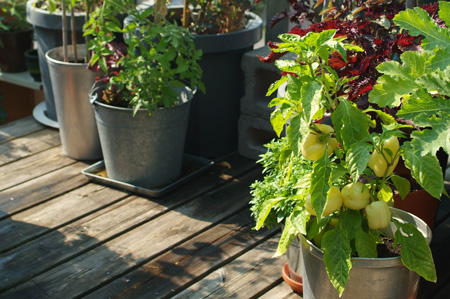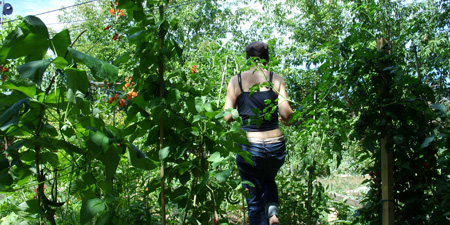
A friend pointed me to this opinion piece in the New York Times that looks at the Eat Local concept as a way to mark environmental impact in food production. The article describes a New Zealand study that challenges the assumption that distance traveled automatically means higher fossil fuel consumption. The study doesn’t undermine the point that local eating advocates make but instead expands the way we are currently looking at energy use to include more factors that arise anywhere in the food production cycle including, “water use, harvesting techniques, fertilizer outlays, renewable energy applications, means of transportation (and the kind of fuel used), the amount of carbon dioxide absorbed during photosynthesis, disposal of packaging, storage procedures and dozens of other cultivation inputs.”
I’ve brought up this article here because although few of us as home gardeners are producing on a massive scale I see urban agriculture and growing food in our own backyards, on rooftops, community gardens, and waste spaces as a way to offset some of our own individual carbon input by eating about as local as it gets — literally stepping out our front or back doors to collect tonight’s dinner. And while that is awesome in itself I have noticed or at least pondered the impact my own small scale food production “systems” may have on the environment. While most of the “factor inputs and externalities†mentioned in the article do not apply to my style of food growing, there are other factors to consider. For example:
- How much tap water do I use in my gardens?
- What kind of packaging is used in products such as organic fertilizers, soil amenders, and container soiless mix? How is this packaging disposed?
- Where do the ingredients in my container soils and amenders come from? For example, are any natural resources being plundered to provide the peat in my mix?
- How far do these products need to travel in order to get to my garden?
- What about the materials used to produce the containers I grow in? How far do they have to travel?
- What about other materials used in the garden? i.e. Stakes, plastic ground covers, tools, etc?
- What about the plants themselves? Are they high-impact energy suckers or are they suitable for this climate and the conditions that exist here?
Having looked at each of these factors I would say that their impact varies depending on the garden or type of garden. For example my community garden plot is in-ground and does not require things like purchased soil, and containers. I employ water-saving methods such as amending my soil, and applying mulch. It’s a fact that container gardens require more water than in-ground gardens and since I can not hook up a rainbarrel system to my apartment, the amount of water used directly from the tap is a whole lot higher than at my community garden plot regardless of how much I mulch the containers, employ water-wise tricks, use greywater, or run outside with buckets when it rains.

I bought packaged soil amenders for the community garden this year and then transported them and myself in a cab from a local garden centre to the alleyway next to my plot. I don’t know where the amenders came from originally although I am hoping that since it was predominantly mushroom compost that it came from somewhere local — yeah it probably didn’t. So in the future I could look into where the amenders are from, buy amenders that are delivered to the curb without packaging, or rely soley on compost from the garden. Thankfully Davin and I have got more composters going at the community garden this year than ever before so that last one is very doable. I walk the bulk of my purchased soil amenders and container soils from the store to my gardens in a granny cart so no fossil fuel inputs there.
As far as containers and container soil goes I feel some relief in that I have been using the same containers and the same soil (with some supplementation of new soil, compost, and other amenders every spring) for several years and will continue to use them for years to come. Many of my containers are recycled items like dresser drawers found on the curb, broken watering cans and busted buckets or items purchased from thrift stores and yard sales.
While I don’t have a special calculating method set up to get a really accurate picture of how my gardens are doing against this sort of equation, through estimation I can guess that the food I grow myself is still generating a much smaller footprint than anything purchased at the grocery store. I’m not absolutely certain about how it holds up against much of the local produce I purchase weekly at the Farmers Market but I would guess that since I am doing a pretty good job of keeping most energy inputs low and adding in the fact that I walk or bike to both gardens and harvest everything by hand my total input has got to be lower still.
What about you? Can you think of any inputs I might be missing in this equation?
Related
- Food That Travels Well – by James E. McWilliams
- Cheap Containers
- Rain Barrels
Hi, Gayla.
Thank you for this thoughtfully-written post. I read it right after this one:
http://property.timesonline.co.uk/tol/life_and_style/property/article1289066.ece
I was doing some self-examination to see how well I’ve been keeping these 10 commandments of eco-gardening and then saw your new post in my RSS reader. Synchronicity!
Lots for me to ponder. I can see ways of being more eco-wise with every input, but particularly water. My balcony gets so hot that I sometimes have to water the smaller containers three times a day! Maybe my attempt to grow an edible garden is too costly! I never really thought about this.
But back to your question. It seems like you’ve thought through all your inputs pretty carefully. I suspect you also save and share seeds although you don’t mention this.
Thank you so much for this entry. I’ve thought a lot about these issues while putting together my first container garden this year. In particular the plastic bags that the soil comes from and how far those bags are being transported. I hadn’t given any thought to the bamboo poles I purchased nor did I know you could use your old container soil with added nutrients for the next gardening season(makes sense!)
this is a great, thought-provoking post! i can’t think of anything you haven’t mentioned here already, but just wanted to add that i’ve personally become more interested in growing only those things that suit my conditions. also, i’ve been thinking a lot about using my container garden to offset the groceries i purchase that spoil quickly, etc.
certainly water consumption is going to be a major issue next year when i expand to the roof.
Totally all valid questions every gardner must ask themselves. This year we installed 2 new rain barrells and next year we will install a third. Occasionally, the barrels go dry, and we must use city water for a couple of days until it rains again. We compost in our backyard, and use mulch around everything we can. Good point about containers.
The other day we made your rust spray and i since i try to figure out how to make everything myself, i was thinking how would i get the sulfur if i couldn’t use molasses? Still haven’t answered that. :)
Totally all valid questions every gardner must ask themselves. This year we installed 2 new rain barrells and next year we will install a third. Occasionally, the barrels go dry, and we must use city water for a couple of days until it rains again. We compost in our backyard, and use mulch around everything we can. Good point about containers.
The other day we made your rust spray and since i try to figure out how to make everything myself, i was thinking how would i get the sulfur if i couldn’t use molasses? Still haven’t answered that. :)
I think water is by far the hardest one to achieve with containers. In addition to many of the other water-saving techniques I would also suggest growing in larger containers that won’t dry out as quickly.
Andie: I’ve been recently having trouble finding the right molasses locally as well. I’m about to give up and look online.
Cristine: It’s amazing but books never address the soil issue. I should really do a post about it because people ask. I always reuse my soil but I supplement with fresh container soil and amenders. The old stuff will have no nutritional value. I also do my own form of container crop rotation where I move the soil used for tomatoes and use it for other plants.
Elaine: That is great synchronicity. And thanks for the link on the 10 commandments.
As an ex-Seattle and now DC container gardener, most stores out west didn’t sell soil or soil amenders with peat, as it is very damaging to the peat bogs to use it for gardening. Rather, a lot of garden companies have started to use use coir instead of peat, which has similar water retention properties. it’s a little different to work with, but I believe much more sustainable. I haven’t done lots of homework on this, but it’s something worth looking into.
For anyone interested in the relationship between water use and crop production the site below is VERY interesting. It explains the concept of virtual water, in other words the amount of water used in the production of a crop and then extends that to the amount of virtual water being traded and exported around the world as that crop is traded. Food for though!
http://www.worldwatercouncil.org/index.php?id=866
Naomi: Coir is better than peat… despite the fact that it is a waste product from coconuts which means it has to travel from tropical locations… proving again that sometimes distance traveled is less harmful than other factors. However the unfortunate thing is that it is harder to come by in some parts of North America especially outside of larger cities. And in many parts of North America peat is still a standard in soiless mixes. We’ve had lengthy discussions in the forums for example about retailers like Walmart being the only “local” supplier for some people depending on where they live.
I can buy bricks of coir here in Toronto to use in making my own container mix. When I do buy a mix instead of making my own the one I buy says it uses peat harvested in a sustainable manner but I have not promoted that product here because it is still not clear to me what the difference is.
one of our forum members did some research into peat and sustainability a while ago:
https://www.yougrowgirl.com/forums/viewtopic.php?t=7986
worth reading. plus, she used two puns in the title! :D
I’ve noticed that the large planters I built need a lot less water. The groupings of smaller containers also seem to lend each other some protection and shade (=less water). It’s tricky and it’s certainly something I think about.
We’re getting most of our produce this year from a CSA. It’s a good forty minute drive out into the country to pick up. There are four families in the area and we each take turns going out each week. The farmers use a drip irrigation system from the run-off from the organic dairy that they’re paired with. I think it IS good, generally, to try to create those buying relationships with local producers. Part of the problem with getting food (or soil, or peat, or toothpaste, or socks) from a zillion miles away has to do with both the physical and psychological distance from the end consumer. So much less accountable.